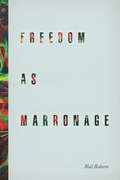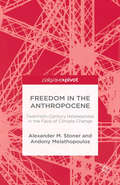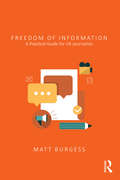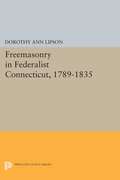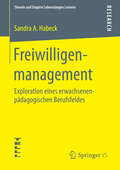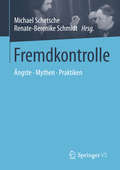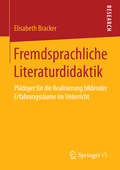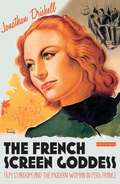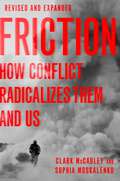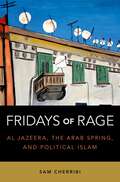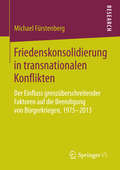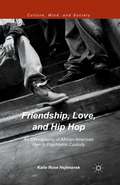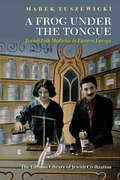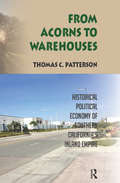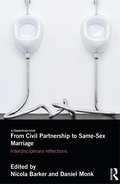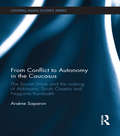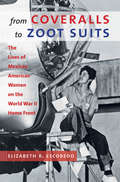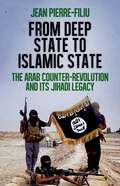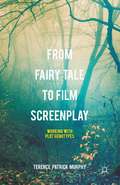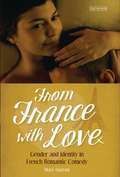- Table View
- List View
Freedom as Marronage
by Neil RobertsWhat is the opposite of freedom? In Freedom as Marronage, Neil Roberts answers this question with definitive force: slavery, and from there he unveils powerful new insights on the human condition as it has been understood between these poles. Crucial to his investigation is the concept of marronage—a form of slave escape that was an important aspect of Caribbean and Latin American slave systems. Examining this overlooked phenomenon—one of action from slavery and toward freedom—he deepens our understanding of freedom itself and the origin of our political ideals. Roberts examines the liminal and transitional space of slave escape in order to develop a theory of freedom as marronage, which contends that freedom is fundamentally located within this space—that it is a form of perpetual flight. He engages a stunning variety of writers, including Hannah Arendt, W. E. B. Du Bois, Angela Davis, Frederick Douglass, Samuel Taylor Coleridge, and the Rastafari, among others, to develop a compelling lens through which to interpret the quandaries of slavery, freedom, and politics that still confront us today. The result is a sophisticated, interdisciplinary work that unsettles the ways we think about freedom by always casting it in the light of its critical opposite.
Freedom as Marronage
by Neil RobertsWhat is the opposite of freedom? In Freedom as Marronage, Neil Roberts answers this question with definitive force: slavery, and from there he unveils powerful new insights on the human condition as it has been understood between these poles. Crucial to his investigation is the concept of marronage—a form of slave escape that was an important aspect of Caribbean and Latin American slave systems. Examining this overlooked phenomenon—one of action from slavery and toward freedom—he deepens our understanding of freedom itself and the origin of our political ideals. Roberts examines the liminal and transitional space of slave escape in order to develop a theory of freedom as marronage, which contends that freedom is fundamentally located within this space—that it is a form of perpetual flight. He engages a stunning variety of writers, including Hannah Arendt, W. E. B. Du Bois, Angela Davis, Frederick Douglass, Samuel Taylor Coleridge, and the Rastafari, among others, to develop a compelling lens through which to interpret the quandaries of slavery, freedom, and politics that still confront us today. The result is a sophisticated, interdisciplinary work that unsettles the ways we think about freedom by always casting it in the light of its critical opposite.
Freedom in the Anthropocene: Twentieth-Century Helplessness in the Face of Climate Change
by A. Stoner A. MelathopoulosFreedom in the Anthropocene illuminates the Anthropocene from the perspective of critical theory. The authors contextualize our current ecological predicament by focusing on the issues of history and freedom and how they relate to our present inability to render environmental threats and degradation recognizable and surmountable.
Freedom of Information: A Practical Guide for UK Journalists
by Matthew BurgessFreedom of Information: A Practical Guide for UK Journalists is written to inform, instruct and inspire journalists on the investigative possibilities offered by the Freedom of Information Act. Covering exactly what the Act is, how to make FOI requests and how to use the Act to hold officials to account, Matt Burgess utilises expert opinions, relevant examples and best practice from journalists and investigators working with the Freedom of Information Act at all levels. The book is brimming with illuminating and relevant examples of the Freedom of Information Act being used by journalists, alongside a range of helpful features, including: • end-of-chapter lists of tips and learning points; • sections addressing the different areas of FOI requests; • text boxes on key thoughts and cases; • interviews with leading contemporary journalists and figures working with FOI requests. Supported by the online FOI Directory (www.foidirectory.co.uk), Freedom of Information: A Practical Guide for UK Journalists is a must read for all those training or working as journalists on this essential tool for investigating, researching and reporting.
Freedom of Information: A Practical Guide for UK Journalists
by Matthew BurgessFreedom of Information: A Practical Guide for UK Journalists is written to inform, instruct and inspire journalists on the investigative possibilities offered by the Freedom of Information Act. Covering exactly what the Act is, how to make FOI requests and how to use the Act to hold officials to account, Matt Burgess utilises expert opinions, relevant examples and best practice from journalists and investigators working with the Freedom of Information Act at all levels. The book is brimming with illuminating and relevant examples of the Freedom of Information Act being used by journalists, alongside a range of helpful features, including: • end-of-chapter lists of tips and learning points; • sections addressing the different areas of FOI requests; • text boxes on key thoughts and cases; • interviews with leading contemporary journalists and figures working with FOI requests. Supported by the online FOI Directory (www.foidirectory.co.uk), Freedom of Information: A Practical Guide for UK Journalists is a must read for all those training or working as journalists on this essential tool for investigating, researching and reporting.
Freemasonry in Federalist Connecticut, 1789-1835
by Dorothy Ann LipsonFreemasonry prescribed for its members a supra-religious, supra-national philosophic universalism. Dorothy Ann Lipson examines its reception and adaptation in America, where its rapid spread was one index of increasing local diversity and cultural change.After tracing the English origins of Masonry, the author focuses on its development in post-Revolutionary Connecticut, where the Calvinist churches and the state had been supported by an unusually homogeneous population. As a counterculture or form of dissent, the fraternity provided its members with a variant religious experience, a source of serial distinction, a stable reference in times of change, a means of education, and an ethically licensed form of recreation. The author considers its role in these areas as well as the implications of such a fraternity tor the lives of women. The confrontation of the Masons and anti-Masons in the first part of the nineteenth century receives special attention as it dramatized political, religious, and cultural diversification.Originally published in 1978.The Princeton Legacy Library uses the latest print-on-demand technology to again make available previously out-of-print books from the distinguished backlist of Princeton University Press. These editions preserve the original texts of these important books while presenting them in durable paperback and hardcover editions. The goal of the Princeton Legacy Library is to vastly increase access to the rich scholarly heritage found in the thousands of books published by Princeton University Press since its founding in 1905.
Freiwilligenmanagement: Exploration eines erwachsenenpädagogischen Berufsfeldes (Theorie und Empirie Lebenslangen Lernens)
by Sandra A. HabeckSandra A. Habeck untersucht das Berufsfeld Freiwilligenmanagement empirisch und zeigt, dass es sich dabei um ein erwachsenenpädagogisches Feld handelt. Die Studie ermöglicht differenzierte Einsichten in Aufgaben, Problemlagen und Herausforderungen des Freiwilligenmanagements aus unterschiedlichen Akteursperspektiven (Vorgesetzte, Freiwillige, Freiwilligenmanager). Sie beleuchtet organisationale Hintergründe und identifiziert drei Ausprägungen der Ehrenamtsarbeit sowie des Freiwilligenmanagements (Führung ehrenamtlichen Personals, persönliche Beziehungsarbeit, pädagogisch gesteuertes Mithandeln). Die Studie ist im Kontext erwachsenenpädagogischer Professions- und Organisationsforschung verortet. Aus den Befunden lassen sich eine Vielzahl an theoretischen, forschungsbezogenen und handlungspraktischen Reflexionshinweisen und Orientierungsmöglichkeiten ableiten.
Fremdkontrolle: Ängste - Mythen - Praktiken
by Michael Schetsche Renate-Berenike SchmidtIm Zentrum des Menschenbildes westlicher Gesellschaften steht die Idee des selbstbestimmt entscheidenden und handelnden Individuums. Entsprechend ist die Vorstellung eines Menschen ohne freien Willen Teil eines anthropologischen, aber auch moralischen und politischen Gegenhorizontes. Wie sehr die Vorstellung einer Bewusstseinskontrolle von Außen uns in den Bann zieht (den der Furcht wie den der Faszination), zeigen Romane und Filme ebenso wie wissenschaftliche und philosophische Debatten. Manche Vorstellungen entspringen eher irrationalen Ängsten, andere entstammen einer schwer zu erhellenden Zwischenwelt, in der sich reale wissenschaftliche Experimente mit Verschwörungstheorien und modernen Mythen mischen.
Fremdsprachliche Literaturdidaktik: Plädoyer für die Realisierung bildender Erfahrungsräume im Unterricht
by Elisabeth BrackerAuf Grundlage eines rezeptionsästhetischen Literaturverständnisses und einer „sinnorientierten Didaktik“ (Gebhard & Combe 2007) rekonstruiert Elisabeth Bracker in ihrer Arbeit Schülergespräche mithilfe der dokumentarischen Methode, die sich an einem literar-ästhetischen Gegenstand im Englischunterricht entzünden. Über die Rekonstruktion ermöglicht die Autorin Einblicke in sprachliche, inhaltliche und interaktional-soziale (Sinnstiftungs-)Prozesse, die sich in einem schulisch inszenierten „literarischen Erfahrungsraum“ abspielen. Insgesamt versteht sich die Arbeit als Plädoyer für die Realisierung bildender Erfahrungsräume im Unterricht.
The French Screen Goddess: Film Stardom and the Modern Woman in 1930s France (International Library of the Moving Image (PDF))
by Jonathan DriskellMany years before Brigitte Bardot and Catherine Deneuve, the French cinema produced a host of glamorous female stars designed to rival their Hollywood counterparts. Bathed in soft light, discussed adoringly in fan magazines and shown wearing the latest fashions, these 'cinematic stars' emerged in opposition to France's traditional stage-based stardom, while remaining, through the roles they played and the looks they sported, a distinctly French phenomenon. This book examines how these stars influenced the narratives and look of their films, contributed to defining the period's new, emancipated femininity, the 'modern woman', and related to the decade's politics, particularly the anti-facist alliance of the 'Front Populaire' during the mid-1930s. It focuses on the three major examples of the period's French screen stardom, Annabella, Danielle Darrieux and Michèle Morgan, while also considering many other key stars, such as Arletty and Viviane Romance, as well as male actors such as Jean Gabin. Key neglected films are considered and true classics of French cinema re-examined, including René Clair's Quatorze juillet, Julien Duvivier's La Bandera and Marcel Carné's Le Quai des Brumes.
Friction: How Conflict Radicalizes Them and Us
by Clark McCauley Sophia MoskalenkoTerrorism is an extreme form of radicalization. In this ground-breaking and important book, Clark McCauley and Sophia Moskalenko identify and outline twelve mechanisms of political radicalization that can move individuals, groups, and the masses to increased sympathy and support for political violence. Co-authored by two psychologists both acknowledged in their field as experts in radicalization and consultants to the Department of Homeland Security and other government agencies, Friction draws on wide-ranging case histories to show striking parallels between 1800s anti-czarist terrorism, 1970s anti-war terrorism, and 21st century jihadist terrorism. Altogether, the twelve mechanisms of political radicalization demonstrate how unexceptional people are moved to exceptional violence in the conflict between states and non-state challengers. In this revised and expanded edition, McCauley and Moskalenko use the twelve mechanisms to analyze recent cases of lone-wolf terrorists and illustrate how individuals can become radicalized to jihadist violence with group influence or organizational support. Additionally, in the context of the Islamic State's worldwide efforts to radicalize moderate Muslims for jihad, they advance a model that differentiates radicalization in opinion from radicalization in action, and suggest different strategies for countering these diverse forms of radicalization. As a result, the authors conclude that the same mechanisms are at work in radicalizing both terrorists and states targeted by terrorists, implying that these conclusions are as relevant for policy-makers and security officers as they are for citizens facing the threat of terror today.
Fridays of Rage: Al Jazeera, the Arab Spring, and Political Islam
by Sam CherribiFridays of Rage reveals Al Jazeera's rise to that most respected of all Western media positions: the watchdog of democracy. Al Jazeera served as the nursery for the Arab world's democratic revolutions, promoting Friday as a "day of rage" and popular protest. This book provides a glimpse into how Al Jazeera strategically cast its journalists as martyrs in the struggle for Arab freedom while promoting itself as the mouthpiece and advocate of the Arab public. In addition to heralding a new era of Arab democracy, Al Jazeera has become a major influence over Arab perceptions of American involvement in the Arab World, the Arab-Israeli conflict, the rise of global Islamic fundamentalism, and the expansion of the political far right. Al Jazeera's blueprint for "Muslim-democracy" was part of a vision announced by the network during its earliest broadcasts. The network embarked upon a mission to reconstruct the Arab mindset and psyche. Al Jazeera introduced exiled Islamist leaders to the larger Arab public while also providing Muslim feminists a platform. The inclusion and consideration of Westerners, Israelis, Hamas, secularists and others earned the network a reputation for pluralism and inclusiveness. Al Jazeera presented a mirror to an Arab world afraid to examine itself and its democratic deficiencies. But rather than assuming that Al Jazeera is a monolithic force for positive transformation in Arab society, Fridays of Rage examines the potentially dark implications of Al Jazeera's radical re-conceptualization of media as a strategic tool or weapon. As a powerful and rapidly evolving source of global influence, Al Jazeera embodies many paradoxes-the manifestations and effects of which we are likely only now becoming apparent. Fridays of Rage guides readers through this murky territory, where journalists are martyrs, words are weapons, and facts are bullets.
Friedenskonsolidierung in transnationalen Konflikten: Der Einfluss grenzüberschreitender Faktoren auf die Beendigung von Bürgerkriegen, 1975–2013
by Michael FürstenbergMichael Fürstenberg untersucht in dieser Studie ausgehend von einem rationalistischen theoretischen Framework, welchen Einfluss externe und grenzüberschreitende Akteure auf die Beendigung von Bürgerkriegen ausüben. Er entwickelt dafür – ausgehend von der Bargaining-Theorie – ein prozessorientiertes Modell der Konfliktbeendigung und prüft die Auswirkungen transnationaler Faktoren mit Hilfe quantitativer Analyseinstrumente auf der Grundlage umfangreicher Daten zu bewaffneten Konflikten zwischen 1975 und 2010. Insgesamt zeigt sich, dass diese eine gewichtige Rolle für die Schaffung und Stabilisierung von Frieden in Krisenregionen spielen, dabei allerdings eine genaue Differenzierung wichtig ist.
Friendship, Love, and Hip Hop: An Ethnography of African American Men in Psychiatric Custody (Culture, Mind, and Society)
by Katie Rose HejtmanekFriendship, Love, and Hip Hop investigates how young Black men live and change inside a mental institution in contemporary America. While the youth in Hejtmanek's study face the rigidity of institutionalized life, they also productively maneuver through what the author analyzes as the 'give' - friendship, love, and hip hop - in the system.
A Frog Under the Tongue: Jewish Folk Medicine in Eastern Europe (The Littman Library of Jewish Civilization)
by Marek TuszewickiWinner of the 2021 Gierowski-Shmeruk PrizeShortlisted for the Folklore Society's Katharine Briggs Award 2021Jews have been active participants in shaping the healing practices of the communities of eastern Europe. Their approach largely combined the ideas of traditional Ashkenazi culture with the heritage of medieval and early modern medicine. Holy rabbis and faith healers, as well as Jewish barbers, innkeepers, and pedlars, all dispensed cures, purveyed folk remedies for different ailments, and gave hope to the sick and their families based on kabbalah, numerology, prayer, and magical Hebrew formulas. Nevertheless, as new sources of knowledge penetrated the traditional world, modern medical ideas gained widespread support. Jews became court physicians to the nobility, and when the universities were opened up to them many also qualified as doctors. At every stage, medicine proved an important field for cross-cultural contacts.Jewish historians and scholars of folk medicine alike will discover here fascinating sources never previously explored—manuscripts, printed publications, and memoirs in Yiddish and Hebrew but also in Polish, English, German, Russian, and Ukrainian. Marek Tuszewicki's careful study of these documents has teased out therapeutic advice, recipes, magical incantations, kabbalistic methods, and practical techniques, together with the ethical considerations that such approaches entailed. His research fills a gap in the study of folk medicine in eastern Europe, shedding light on little-known aspects of Ashkenazi culture, and on how the need to treat sickness brought Jews and their neighbours together.
From Acorns to Warehouses: Historical Political Economy of Southern California’s Inland Empire
by Thomas C PattersonThomas C. Patterson’s large-scale history of the Inland Empire of Southern California traces the social, political and economic changes in this region from the first Native American settlement 12,000 years ago to the present. Framing his discussion of this region in the general growth trajectory of California’s socio-economic history, he is able to connect landscape, resources, wealth, labor, and inequality using a Marxian framework for many key periods of the region’s history. In moving between large scale historical changes, regional adaptations and resistance to those changes, and a framework that places those responses in theoretical context, Patterson’s work allows the reader to see how inland Southern California developed into the warehouse empire of the 21st century and its prospects for the future.
From Acorns to Warehouses: Historical Political Economy of Southern California’s Inland Empire
by Thomas C PattersonThomas C. Patterson’s large-scale history of the Inland Empire of Southern California traces the social, political and economic changes in this region from the first Native American settlement 12,000 years ago to the present. Framing his discussion of this region in the general growth trajectory of California’s socio-economic history, he is able to connect landscape, resources, wealth, labor, and inequality using a Marxian framework for many key periods of the region’s history. In moving between large scale historical changes, regional adaptations and resistance to those changes, and a framework that places those responses in theoretical context, Patterson’s work allows the reader to see how inland Southern California developed into the warehouse empire of the 21st century and its prospects for the future.
From Civil Partnership to Same-Sex Marriage: Interdisciplinary Reflections
by Nicola Barker Daniel MonkThe Civil Partnership Act 2004 and the Marriage (Same Sex Couples) Act 2013 are important legal, social and historical landmarks, rich in symbolic, material and cultural meanings. While fiercely opposed by many, within mainstream narratives they are often represented as a victory in a legal reform process that commenced with the decriminalisation of homosexuality. Yet, at the same time, for others they represent a problematic and ambivalent political engagement with the institution of marriage. Consequently, understood or labelled as ‘revolutionary’, ‘progressive’ and ‘conservative’, these legal reforms provide a space for thinking about issues that arguably affect everyone, regardless of sexual orientation or relationship status. This edited collection brings together scholars and commentators from a range of backgrounds, generations and disciplines to reflect on the first ten years of civil partnerships and the introduction of same-sex marriage. Rather than rehearsing the arguments ‘for’ and ‘against’ relationship recognition, the essays ask original questions, draw on a variety of methods and collectively provide a detailed and reflective ‘snap shot’ of a critical moment, a ‘history of the present’ as well as providing a foundation for innovative ways of thinking about and engaging with the possibilities and experiences arising from the new reality of relationship recognition for gays and lesbians.
From Civil Partnership to Same-Sex Marriage: Interdisciplinary Reflections
by Nicola Barker Daniel MonkThe Civil Partnership Act 2004 and the Marriage (Same Sex Couples) Act 2013 are important legal, social and historical landmarks, rich in symbolic, material and cultural meanings. While fiercely opposed by many, within mainstream narratives they are often represented as a victory in a legal reform process that commenced with the decriminalisation of homosexuality. Yet, at the same time, for others they represent a problematic and ambivalent political engagement with the institution of marriage. Consequently, understood or labelled as ‘revolutionary’, ‘progressive’ and ‘conservative’, these legal reforms provide a space for thinking about issues that arguably affect everyone, regardless of sexual orientation or relationship status. This edited collection brings together scholars and commentators from a range of backgrounds, generations and disciplines to reflect on the first ten years of civil partnerships and the introduction of same-sex marriage. Rather than rehearsing the arguments ‘for’ and ‘against’ relationship recognition, the essays ask original questions, draw on a variety of methods and collectively provide a detailed and reflective ‘snap shot’ of a critical moment, a ‘history of the present’ as well as providing a foundation for innovative ways of thinking about and engaging with the possibilities and experiences arising from the new reality of relationship recognition for gays and lesbians.
From Conflict to Autonomy in the Caucasus: The Soviet Union and the Making of Abkhazia, South Ossetia and Nagorno Karabakh (Central Asian Studies)
by Arsène SaparovThis book is the first historical work to study the creation of ethnic autonomies in the Caucasus in the 1920s – the transitional period from Russian Empire to Soviet Union. Seventy years later these ethnic autonomies were to become the loci of violent ethno-political conflicts which have consistently been blamed on the policies of the Bolsheviks and Stalin. According to this view, the Soviet leadership deliberately set up ethnic autonomies within the republics, thereby giving Moscow unprecedented leverage against each republic. From Conflict to Autonomy in the Caucasus questions this assumption by examining three case studies: Abkhazia, South Ossetia and Nagorno Karabakh are placed within the larger socio-political context of transformations taking place in this borderland region during the nineteenth and twentieth centuries. It examines demographic, social and economic consequences of the Russian colonization and resulting replacement of traditional societies and identities with modern ones. Based on original Russian language sources and archival materials, the book brings together two periods that are usually studied separately – the period of the Russian Civil War 1917–20 and the early Soviet period – in order to understand the roots of the Bolshevik decision-making policy when granting autonomies. It argues that rather than being the product of blatant political manipulation this was an attempt at conflict resolution. The institution of political autonomy, however, became a powerful tool for national mobilization during the Soviet era. Contributing both to the general understanding of the early Soviet nationality policy and to our understanding of the conflicts that have engulfed the Caucasus region since the 1990s, this book will be of interest to scholars of Central Asian studies, Russian/Soviet history, ethnic conflict, security studies and International Relations.
From Conflict to Autonomy in the Caucasus: The Soviet Union and the Making of Abkhazia, South Ossetia and Nagorno Karabakh (Central Asian Studies)
by Arsène SaparovThis book is the first historical work to study the creation of ethnic autonomies in the Caucasus in the 1920s – the transitional period from Russian Empire to Soviet Union. Seventy years later these ethnic autonomies were to become the loci of violent ethno-political conflicts which have consistently been blamed on the policies of the Bolsheviks and Stalin. According to this view, the Soviet leadership deliberately set up ethnic autonomies within the republics, thereby giving Moscow unprecedented leverage against each republic. From Conflict to Autonomy in the Caucasus questions this assumption by examining three case studies: Abkhazia, South Ossetia and Nagorno Karabakh are placed within the larger socio-political context of transformations taking place in this borderland region during the nineteenth and twentieth centuries. It examines demographic, social and economic consequences of the Russian colonization and resulting replacement of traditional societies and identities with modern ones. Based on original Russian language sources and archival materials, the book brings together two periods that are usually studied separately – the period of the Russian Civil War 1917–20 and the early Soviet period – in order to understand the roots of the Bolshevik decision-making policy when granting autonomies. It argues that rather than being the product of blatant political manipulation this was an attempt at conflict resolution. The institution of political autonomy, however, became a powerful tool for national mobilization during the Soviet era. Contributing both to the general understanding of the early Soviet nationality policy and to our understanding of the conflicts that have engulfed the Caucasus region since the 1990s, this book will be of interest to scholars of Central Asian studies, Russian/Soviet history, ethnic conflict, security studies and International Relations.
From Coveralls to Zoot Suits: The Lives of Mexican American Women on the World War II Home Front
by Elizabeth R. EscobedoDuring World War II, unprecedented employment avenues opened up for women and minorities in U.S. defense industries at the same time that massive population shifts and the war challenged Americans to rethink notions of race. At this extraordinary historical moment, Mexican American women found new means to exercise control over their lives in the home, workplace, and nation. In From Coveralls to Zoot Suits, Elizabeth R. Escobedo explores how, as war workers and volunteers, dance hostesses and zoot suiters, respectable young ladies and rebellious daughters, these young women used wartime conditions to serve the United States in its time of need and to pursue their own desires.But even after the war, as Escobedo shows, Mexican American women had to continue challenging workplace inequities and confronting family and communal resistance to their broadening public presence. Highlighting seldom heard voices of the "Greatest Generation," Escobedo examines these contradictions within Mexican families and their communities, exploring the impact of youth culture, outside employment, and family relations on the lives of women whose home-front experiences and everyday life choices would fundamentally alter the history of a generation.
From Deep State to Islamic State: The Arab Counter-Revolution and its Jihadi Legacy
by Jean-Pierre FiliuIn his disturbing and timely book Jean-Pierre Filiu lays bare the strategies and tactics employed by the Middle Eastern autocracies, above all those of Syria, Egypt, Yemen and Algeria, that set out to crush the democratic uprisings of the 'Arab Revolution.' In pursuit of these goals they turned to the intelligence agencies and internal security arms of the 'deep state,' the armed forces, and to street gangs such as the Shabiha to enforce their will. Alongside physical intimidation, imprisonment and murder, Arab counter-revolutionaries discredited and split their opponents by boosting Salafi-Jihadi groups such as Islamic State. They also released from prison hardline Islamists and secretly armed and funded them. The full potential of the Arab counter-revolution surprised most observers, who thought they had seen it all from the Arab despots: their perversity, their brutality, their voracity. But the wider world underestimated their ferocious readiness literally to burn down their countries in order to cling to absolute power. Bashar al-Assad clambered to the top of this murderous class of tyrants, driving nearly half of the Syrian population in to exile and executing tens of thousands of his opponents. He has set a grisly precedent, one that other Arab autocrats are sure to follow in their pursuit of absolute power.
From Fairy Tale to Film Screenplay: Working with Plot Genotypes
by Terence Patrick MurphyIn Screenplay: The Foundations of Screenwriting (1979), Syd Field first popularized the Three-Act Paradigm of Setup, Confrontation and Resolution for conceptualizing and creating the Hollywood screenplay. For Field, the budding screenwriter needs a clear screenplay structure, one which includes two well-crafted plot points, the first at the end of Act I, the second at the end of Act II. By focusing on the importance of the four essentials of beginning and end, and the two pivotal plot points, Field did the Hollywood film industry an enormous service. Nonetheless, although he handles the issue of overall structure expertly, Field falls down when offering the screenwriter advice on how to successfully build each of the three individual Acts. This is because Field did not recognize the importance of another layer of analysis that underpins the existence of plot points. This is the level of the plot genotype.This book will offer you a richer theory of plot structure than the one Field outlines. It will do this not by contradicting anything Field has to say about the Hollywood paradigm, but by complementing it with a deeper level of analysis. Plot genotypes are the compositional schemas of particular stories. They are sets of instructions, written in the language of the plot function, for executing particular plots. This book outlines the plot genotypes for The Frog Prince, The Robber Bridegroom, Puss-in-Boots, and Little Red Riding Hood and then shows how these genotypes provide the underpinnings for the film screenplays of Pretty Woman, Wrong Turn, The Mask, and Psycho. By means of a detailed study of these four Hollywood screenplays, you will be able to offer a much richer description of what is going on at any particular point in a screenplay. In this way, you will become much sharper at understanding how screenplays work. And you will become much better at learning how to write coherent screenplays yourself.
From France With Love: Gender and Identity in French Romantic Comedy (International Library of the Moving Image (PDF))
by Mary HarrodLove stories have always been at the heart of French cinema, but romantic comedies have, until recently, been absent from it. In 2001, the global success of Amélie catalysed a major development in the Western world's second-largest film industry: the appropriation of the 'Hollywood' romantic comedy genre (or Rom-Com à l'Américaine). In From France with Love, Mary Harrod explores this contemporary phenomenon, examining both local hits and films with international status. Using socio-cultural data, box-office figures and analysis of critical reception, she reveals the ways in which these films mirror shifting attitudes towards gender roles within French society, as well as the increasingly important interrelation between French national cinema and transnational filmmaking paradigms.
